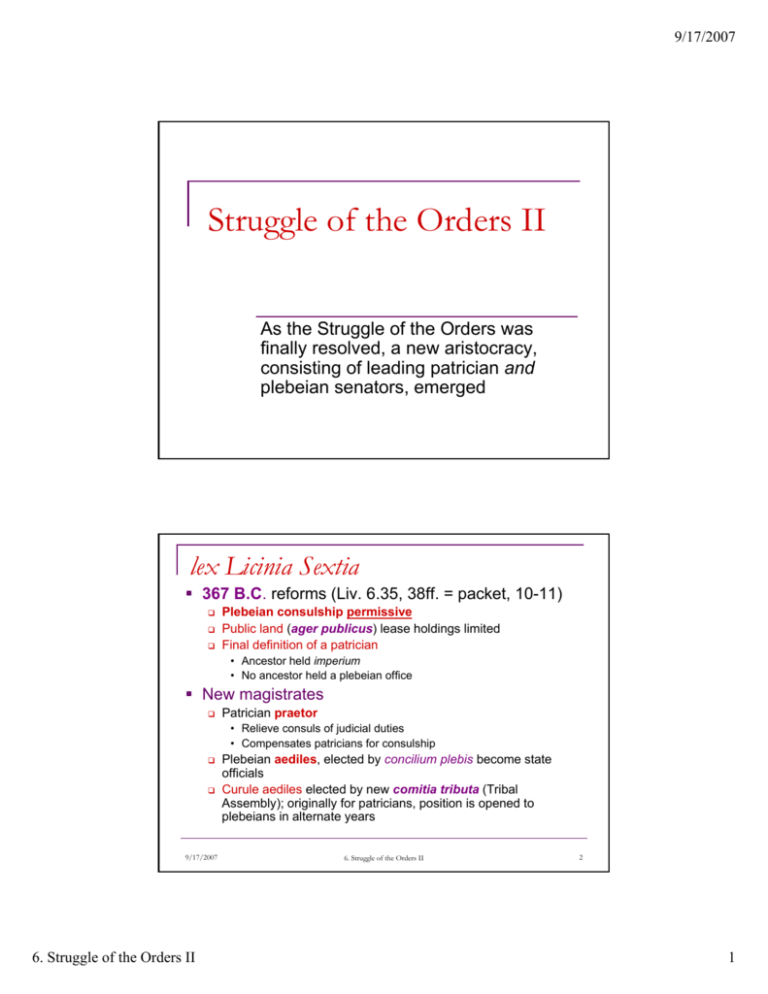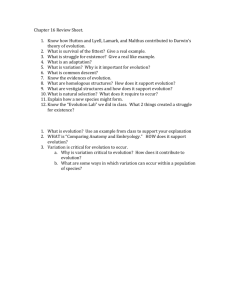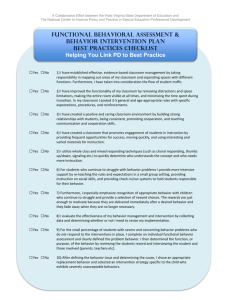Struggle of the Orders II
advertisement

9/17/2007 Struggle of the Orders II As the Struggle of the Orders was finally resolved, a new aristocracy, consisting of leading patrician and plebeian senators, emerged lex Licinia Sextia 367 B.C. reforms (Liv. 6.35, 38ff. = packet, 10-11) Plebeian consulship permissive Public land (ager publicus) lease holdings limited Final definition of a patrician • Ancestor held imperium • No ancestor held a plebeian office New magistrates Patrician praetor • Relieve consuls of judicial duties • Compensates patricians for consulship 9/17/2007 6. Struggle of the Orders II Plebeian aediles, elected by concilium plebis become state officials Curule aediles elected by new comitia tributa (Tribal Assembly); originally for patricians, position is opened to plebeians in alternate years 6. Struggle of the Orders II 2 1 9/17/2007 Rome and the Samnites Sabellians – Oscan speaking mountain peoples “cascade” down the length of Italy Samnites Campanians (Oscans who settle in Campania but adopt local, “luxurious” culture) Lucanians First Samnite War (343–341 B.C.) Samnites become the strongest group in Italy, threaten their cousins in Campania Roman movements towards Campania bring them into conflict with the Samnites 9/17/2007 6. Struggle of the Orders II 3 Results of First Samnite War Mutiny of 342 B.C. Army in the field year-round Coincides with the lex Genucia: plebeian consulship obligatory Latin Revolt 340–338 B.C. Campanians betrayed and Latins angered by RomanSamnite peace Romans defeat their two former allies with Samnite help! Latin League broken up, Latin and Campanian territory annexed 9/17/2007 6. Struggle of the Orders II 6. Struggle of the Orders II 4 2 9/17/2007 Second Samnite War 328–302 B.C., a long conflict Pretext: Neapolis stasis Rival Greek parties call in Samnites and Romans Lex Poetilia, 326 B.C. nexum abolished Battle of Caudine Forks, 321 B.C. Roman army “under the yoke” Dangers of mountain warfare, manipular formation perfected Rome resumes war in 316 B.C. Via Appia built to Campania Etruscan danger neutralized Samnium encircled with alliances Samnites end conflict, become “friends” (amici) 9/17/2007 6. Struggle of the Orders II 5 End of the Struggle 300 B.C., lex Ogulnia Priestly colleges (pontifs and augurs) opened to plebeians Third Samnite War (298–290 B.C.) Lucania a Roman ally, Samnium surrounded on all sides “Grand Alliance” of Samnites, Etruscans, and Gauls defeated at Sentium Devotio of Decius Mus tests the validity of plebeian priesthood Defeated Samnites become socii, allies with obligations 287 B.C., lex Hortensia Plebiscites binding without patrum auctoritas, equivalent to leges Concilium Plebis becomes a legislative body 9/17/2007 6. Struggle of the Orders II 6. Struggle of the Orders II 6 3 9/17/2007 Achievements of the Struggle Political plebeians gain political, social, and religious equality with patricians Can hold all offices, can intermarry, can serve in priestly colleges Economic advances relatively minor Monopoly on ager publicus limited Debt slavery (nexum) abolished late • Reward to constituents? Emergence of a new ruling class: the nobiles Descendants of those who had held the consulship A patricio-plebeian senatorial aristocracy 9/17/2007 6. Struggle of the Orders II 6. Struggle of the Orders II 7 4









